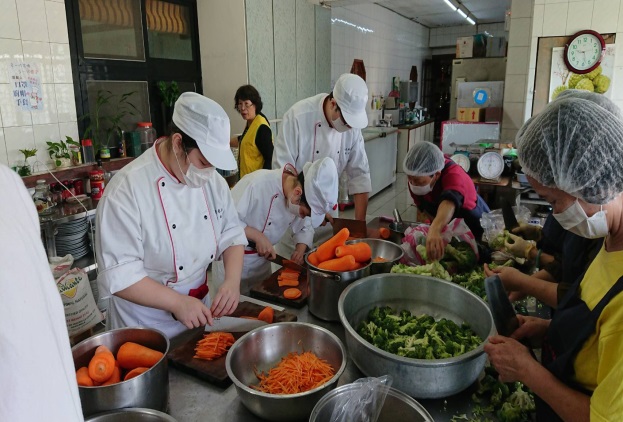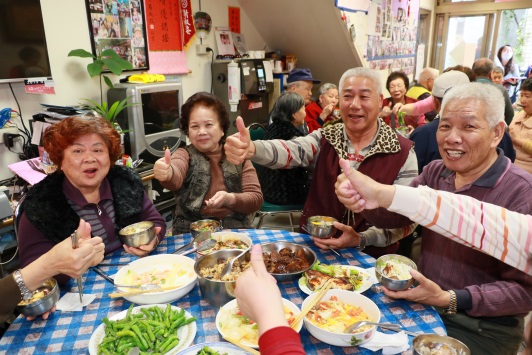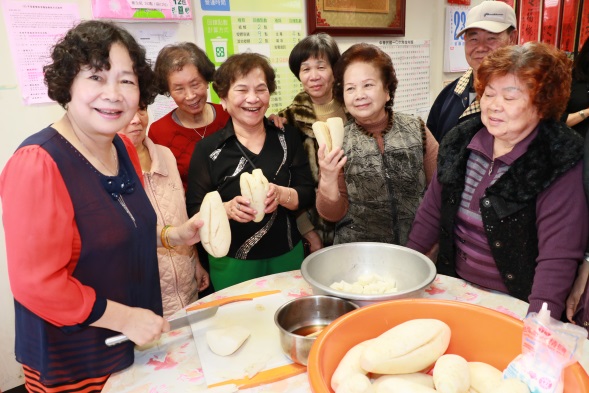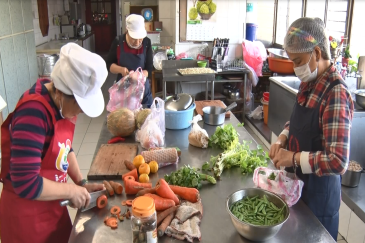 - © New Taipei City Government
- © New Taipei City Government - © New Taipei City Government
- © New Taipei City Government - © New Taipei City Government
- © New Taipei City Government - © New Taipei City Government
- © New Taipei City Government - © New Taipei City Government
- © New Taipei City Government - © New Taipei City Government
- © New Taipei City Government - © New Taipei City Government
- © New Taipei City Government
City
New Taipei
Main actors
City Government, Private Sector, NGO / Philanthropy, Community / Citizen Group
Project area
Whole City/Administrative Region
Duration
Ongoing since 2016
Food waste-reduction programs help children and the needy.
The New Taipei City Surplus Food Network (NTCSFN) collects vegetables, fruit, and other edible products that have an unattractive appearance from the New Taipei City markets and sends them to the Social Welfare Department for distribution. Other social-welfare and private organizations help the government to implement similar programs, so that resources can be flexibly provided to people in need. Individual donations to facilitate the implementation of such programs are also accepted.
To enhance citizens’ identification with, and participation in, these food-saving activities, the concept is promoted through education, as well as in various channels of the food industry (e.g., restaurants and businesses), thereby reducing food waste in the city.
This case study has been documented through the Metropolis pilot project "Surplus Food Network", which promoted exchanges between public officials from New Taipei, Medellín and Quito on how to reduce food waste while strengthening service delivery and expanding citizens’ participation, between 2018 and 2019.
The Food and Agriculture Organization of the United Nations (FAO) has reported that one-third of the food produced annually worldwide is lost or wasted, while 700 million people live in hunger. Despite the advancement of agricultural and food technologies, the problem of hunger persists. By 2050, food production must increase by 106% of that amount produced in 2005 to meet the needs of the growing global population. Considering the serious threats of climate change and population explosion, cities must pay attention to resolving food problems and develop relevant food wastage–reduction strategies.
In New Taipei City, agricultural production is not a primary activity. However, because the city has a convenient transportation system and abundant business development, people can easily obtain diverse low-priced foods that meet their needs. Moreover, only “good looking” foods are sold in the market to attract consumers, whereas those with an unattractive appearance are discarded before they reach the market. In 2018, the amount of food waste in New Taipei City was 26,028 tonnes. In addition, the statistics of the Department of Environmental Protection have shown that the amount of kitchen waste was 140,000 tonnes. However, only food waste from shops and businesses was reported. Food disposed of by private households remains unaccounted for. Therefore, the total amount of food waste may be higher than that recorded in governmental statistics.
The NTCSFN is an interdepartmental network in the city government, where various departments are responsible for food initiatives and different aspects of surplus food promotion. The NTCSFN mainly focuses on public welfare; therefore, the Social Welfare Department is the major department in charge of the operation of the food waste-reduction program, including the management of food matching, sorting, delivery, and coordination between departments.
Currently, New Taipei City has 14 active community service sites in this food distribution model.
Partnership with the private sector
The New Taipei City Government–private sector collaboration can be divided into three stages:
1. Matching
The Banqiao and Sanchong markets of the New Taipei City Fruit and Vegetable Marketing Co. Ltd. serve as fair-trade platforms of agricultural produce between farmers and wholesalers. A large amount of fruit and vegetables circulate in these markets on workdays. After purchasing a large amount of fruit and vegetables, vendors may select produce with unattractive appearances and provide them to the NTCSFN. Local private and public markets may also donate unsold food ingredients, such as meat, vegetables, fruit, and seafood, at specific time and locations. These ingredients are then delivered by food companies to community service sites by food transport vehicles. The Health and Agriculture Departments of the city help during the food matchmaking process.
2. Sorting and transportation
In the second stage, food donated by market vendors is sorted by volunteers. The volunteers discard food that is completely unusable and allocate the remaining food according to the need of each community service site. The allocated food is then delivered to each site by a “surplus food vehicle.” The city government has been commissioning an association to oversee the personnel and relevant management for the surplus food vehicles since 2017.
3. Utilization
In the final stage, food is delivered to community service sites that hold congregate meals. The government also cooperates with social welfare organizations and churches that organize congregate meals for older adults or those providing academic assistance to children, so that the food can be fully used.
Food-waste prevention at schools
Because most children who receive compulsory education have a daily school lunch, a huge amount of lunch food is required by a total of 298 schools in New Taipei City. However, the students’ eating habits and preferences for certain dishes sometimes lead to a large amount of leftovers. Accordingly, the “Empty Plate Movement” has been launched; this program reduces food waste by providing students a fixed quantity of food and by receiving feedback from school lunch suppliers regarding the students’ food preferences. The Education Department of New Taipei City Government has developed a “dish scale”, which is based on the nutrients needed by school students of all ages. On the basis of the dish scale, students receive a fixed amount of food, and they can ask for more food only when the amount is insufficient for them. This measure increases the proportion of students finishing all the dishes in their meal. In addition, lunch suppliers are asked to be responsive to the feedback regarding the dishes in order to reduce the food waste resulting from the students’ dish preferences. The unconsumed food is packaged and refrigerated and later provided to students from disadvantaged families to take home for dinner.
Food waste preventions at restaurants
According to a national survey on eating out, conducted in November 2018 in Taiwan among people aged 25–35 years, 94% ate out every week and 58% had at least one such meal daily. Considering the high percentage of citizens eating out, the Department of Health of New Taipei City Government has collaborated with banquet halls and banquet restaurants under its jurisdiction and implemented the “Leftover Packing-Up Project”. In this project, waiters provide suggestions to customers regarding food serving sizes, to prevent customers from ordering too much. After the meal, the waiters also encourage customers to pack up the leftovers. Moreover, the Department of Health cooperates with catering-related experts to design surplus food recipes, thus teaching people how to transform the leftovers into delicious meals. The Agricultural Department cooperates with small restaurants and encourages them to purchase unattractive-appearing vegetables and fruit, organically grown by smallholder farmers. This helps to stabilize the sales channels among young organic farmers. In addition, some restaurants provide places for people to collect the vegetables and fruit with an unattractive appearance that they have ordered; this strategy reduces the farmers’ costs that are involved in the traditional production–distribution model.
Through the accreditation of green circle shops and the incorporation of food-saving processes into the accreditation indicators, the Department of Environmental Protection conducts inspection controls and also provides relevant support for restaurant chains and hotel restaurants regarding their control and management of food ingredient purchasing, menu planning, and the disposal of unused food ingredients. The result of all these measures has reduced this type of food waste by at least 80 tonnes annually.
Awareness raising: Christmasland
To enhance the visibility of the food-saving concept, during the annual Christmasland event, the Department of Agriculture holds a Surplus Food Sharing event, where businesses related to surplus food sharing are invited to run booths. Relevant activities and short talks help citizens to understand the concept and importance of food-saving.
The New Taipei City Surplus Food Network was established and is financed by New Taipei City government.
From August 2016 to July 2019, 356,531 kg of food was saved and redistributed through social services; this benefited 421,060 people.
As a next step, the New Taipei City Government will evaluate the possibility of a collaboration with food processing plants. The food processing plants use professional technologies to process the excessive amount of fruit and vegetables harvested in season and also to extend their expiration dates. Therefore, more food can be redistributed and saved.
In the past, the business food waste of New Taipei City would have been processed into feed, fertilizer or be buried or incinerated by specific units. In cooperation with the Environmental Protection Agency, some schools have set up kitchen waste machines. Thanks to this, kitchen waste in schools can be fermented into fertilizer and used in the vegetable gardens of the schools.
1. Traditional values
People generally have a negative impression of surplus food and food products that have an unattractive appearance. Households prefer to not purchase food ingredients that have an unattractive appearance unless they have economic difficulties or other considerations. Food appearance seems to symbolize a consumer’s status. In New Taipei City, some community service sites participating in the NTCSFN care a lot about food appearance and about the quality of the donated food. If the food delivered to the communities is spoiled, it may cause dissatisfaction among the community members.
2. Contemporary health concepts
Thanks to economic development, food accessibility and affordability have increased. In addition, people are being exposed to healthy diet concepts, such as avoiding eating leftovers and reheating cooked food because the reheating process may produce materials harmful to the body. People’s curiosity about the taste of various foods and the increase of their spending power also cause them to become unwilling to take leftovers back home. These factors can lead to continuous food waste.
3. Difficulty of changing citizens’ preferences
Taiwan was an agrarian society, and the notion of food-saving has been passed down for many generations. However, this has not led to a reduction in household food waste. The reason for this situation is that households tend to purchase too much food on impulse or out of worry of insufficiency. Moreover, homemakers have difficulty in estimating the food portions they need to prepare because some family members may eat outside unexpectedly. This can lower their intention to cook at home, and the purchased food may therefore expire and be discarded at the last moment.
4. Cooperation with the private sector
No taxation laws encourage direct donation, and the donation-making procedures are complicated. The delivery costs after a donation are also a factor influencing businesses’ willingness to donate.
Regarding the implementation of the existing programs, it is recommended that the government cooperates with nonprofit organizations that possess a central kitchen. Then, in addition to directly using the food for congregate meals, the food can be made into boxed meals or frozen foods to be provided to older people who live alone or to disadvantaged households in rural areas. This can help the government to effectively distribute surplus food to the public.
The New Taipei City Government has exchanged opinions and experiences regarding food policy promotion with Quito, Ecuador and Medellin, Colombia, through the Metro Surplus Food Program (see documents and resources referenced below).
Metropolis pilot project publication: https://www.metropolis.org/sites/default/files/resources/Metropolis_Surplus-food.pdf
External links / documents
On Map
The Map will be displayed after accepting cookie policy